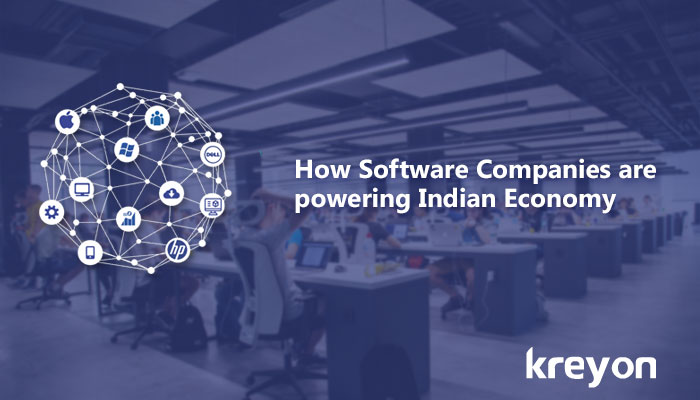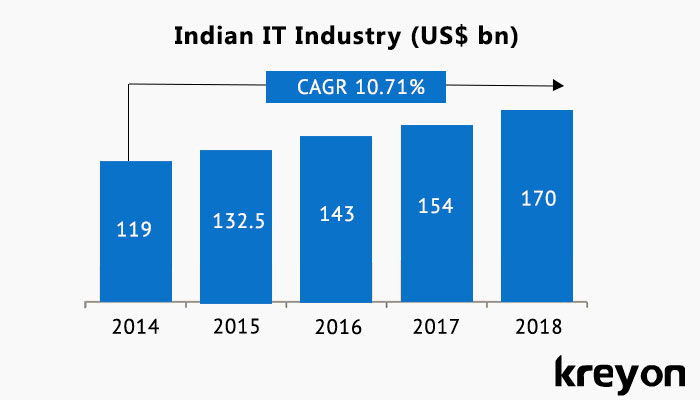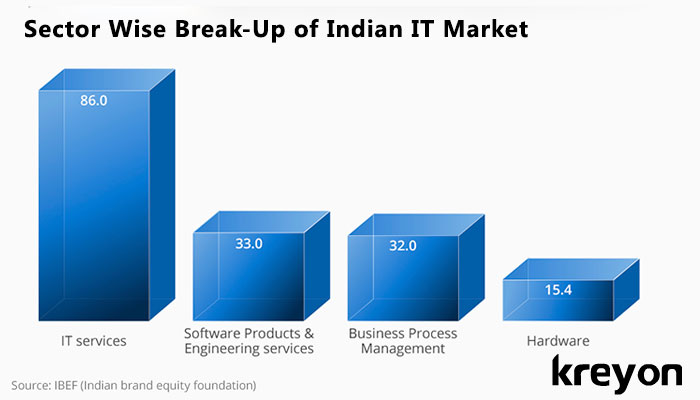How Software Companies are powering Indian Economy

The Information technology revolution has put India on the world map. The software services and products are fuelling the country’s economy and GDP like never before.
India is now the sixth largest economy in the world by nominal GDP and third largest by purchasing power parity. In 2018, India’s economy became the world’s fastest growing major economy surpassing China as per International Monetary Fund (IMF).
The IT or software industry contributes nearly eight percent of the total Indian GDP as of 2018. Two decades ago in 1998, the total contribution was 1.2 percent.
As per the report from IBEF, the IT Services sector in 2018 accounts for $86 billion in revenue. The total revenue is pegged at $170 billion dollars. Clearly, the growth indicates a big push for Indian software products and services companies.
Brief History

It may be recalled that Indian IT Services industry was born in Mumbai in 1967 with a Tata group company. The first export zone was set up in SEEPZ, Mumbai. Today, India has many modern IT parks which rank among the very best in the world.
There were companies like TCS, Patni computer systems, Infosys, Wipro, HCL, that powered Indian software services industry in the eighties and nineties to build a phenomenal story of ambition and growth.
The Indian IT industry has come a long way from its early days and now earns over $170 billion in revenue with a presence in more than 80 countries.
The emerging technologies and digitisation of industries are now powering more Indian companies to greater heights. With the push for digitisation across businesses and industries, the software industry in India may well be poised for its best years ahead.
The ecommerce boom and the digital revolution have already made some of these Indian companies earn the coveted Unicorn status. Companies like Flipkart, Ola, Paytm, Quikr etc have given new thrust to the Indian growth story.
The emerging technologies and software products in India are drawing major funds from venture capitalists around the world like Accel Partners, Helion Venture partners, Softbank, Sequoia Capital, Nexus Venture partners etc.
The Transition Phase
The software and technology industry is changing fast. Today artificial intelligence, machine learning, advanced analytics, mobility and cloud based technologies are driving the agenda for the software demand.
The obsolete models of the industry are no longer relevant in the modern world. The incumbents of the industry are trying to adapt to the new spectrum of technology. There is a resurgence of companies with fresh ideas, niche offerings and software product development expertise.
It is no longer big vs small but more about fast vs slow in the industry. Even smaller software companies have equal chances of grabbing the big deals and catapult themselves into global recognition.
Software Companies in demand

The software companies, which are catering to the market demand are growing and prospering in this dynamic industry. India is the topmost offshoring destination for IT companies in the world.
The software companies with intellectual properties or the right software products for a global scale and audience have a gamut of opportunities today.
The software products and intellectual property are key differentiators that are helpful in attracting the right push for scaling companies. The brand image of India in the software industry coupled with lucrative export opportunities are driving new companies.
The Indian software product startups have a great chance of making their presence felt on a global stage. The scale and reach is dictated by the quality and depth of the software products for the target markets.
India is the digital capital of world with approximately 75% of the global digital talent as per IBEF. The Indian IT and Business Process Automation & Management industry is expected to grow to $350 billion by 2025.
The Road Ahead

NASSCOM president says that the software industry is in the most exciting phase right now. The opportunities that lie ahead are unprecedented.
Debjani Ghosh, President, NASSCOM, remarks, “The most exciting thing about this industry right now and the sector right now is that we have, ahead of us, opportunities that we have never seen before.”
Debjani Ghosh further says, “Technology touches everything, it touches every single industry, it touches every single country, it is shaping not just the future and destiny of companies, but it is shaping the destiny of countries, of nations.”
She adds, “The need for technology services, technology solutions, and the need for IT to get integrated into your business strategy is tremendously high. We have never seen anything like this.”
The software industry is typically driven by strong export demand and digitisation. There is also a constantly growing market for software within India. With the booming ecommerce and digital market, the industry may see continued growth for a long time.
Conclusion
The availability of wide talent pools for developing software remains India’s key strength. There is wide range of experience available in the industry and continual addition of engineering graduates further adds to the world class pool.
Digitisation and digital disruptions are only multiplying India’s prowess as a global outsourcing destination of choice. Even small software and technology companies are growing rapidly and becoming instrumental in the Indian growth story.
